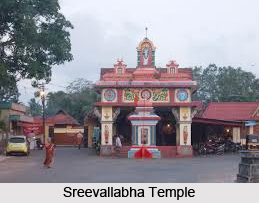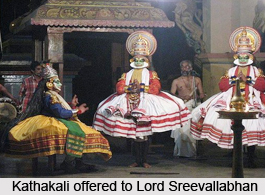 History of Sreevallabha Temple dignifies the legend behind Lord Vishnu. This place in South India is one of the earliest settlements in India.
History of Sreevallabha Temple dignifies the legend behind Lord Vishnu. This place in South India is one of the earliest settlements in India.
Thiruvalla was once a village among 64 Namboothiri villages in Kerala. Since this place is situated at the mouth (vai) of Manimala River (Valla River) it had been known as "vallavai" and later transformed into "thiruvalla".
Early History of Sreevallabha Temple
The historical evidences point out the place had been populated by humans before 3000 BC. Tiruvalla inscriptions say the temple for Sudarshana Chakra was built in 2998 BC. Another opinion is that the place was named after Sreevallabha Temple as Sreevallabhapuram and Thiruvalla in colloquial Malayalam. The temple for Sudarshana Chakra was built by Sreedevi Antherjanam of Sankramangalathu Illam and it was elaborately rebuilt by Queen Cherumthevi in 59 BC. Sreevallabha temple flourished to a major spiritual and educational centre by AD 1100. The temple had governed a Vedic school (Thiruvalla Sala) with around 1500 students and 150 teachers. Veda, Vedanta, Tarka, Mimamsa, Jyotisha, Ayurveda, Kalaripayattu were taught here.
 Medieval History of Sreevallabha Temple
Medieval History of Sreevallabha Temple
Sreevallabha Temple also owned an ayurvedic hospital with facilities to admit and treat 100 patients at a time. Addressing lord Sreevallabhan by names Kolapiran, Thiruvazhmarvan and Sundarayan, the Tamil vaishnavite saints Nammalvar of the 5th century AD (2612-2622 in Divya Prabhandham) and Thirumangai Alvar of the 9th century AD (paasurams 1806-1817 in Divya prabhandham) had praised glory of the temple. Famous Sanskrit poet Dandin (7th century AD) of Kanchi mentioned the temple in his works. The first ever prose work in Malayalam is the Thiruvalla inscriptions dated first half of the 12th century AD, which was obtained from the temple during 1915. The famous Unnuneeli Sandesam of the 13th century AD highlighted the grandeur, beauty, serenity, fame and status of the temple during its time.
Modern History of Sreevallabha Temple
Sreevallabha Temple was under control of Thiruvalla Pattillathil Pottimar (Brahmins of ten families) till 1752-1753. Sreevallabha Temple emerged out as a major spiritual destination for devotees all over India centuries before. It had 15 major priests (melsanthi) and 180 sub-ordinate priests (keezhsanthi) all the time and another 108 for only daily noon pooja. Sreevallabha Temple provided staying and food facilities for all visitors, students, teachers etc. and also used to conduct annadanam (serving food to the poor) daily. Naivedyam of Lord Sreevallabhan for a single time used to be made from 45 para (one para can feed approx 100 persons) rice.





















